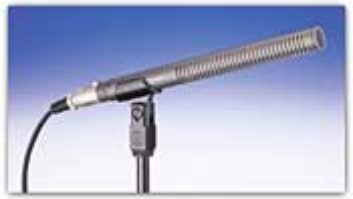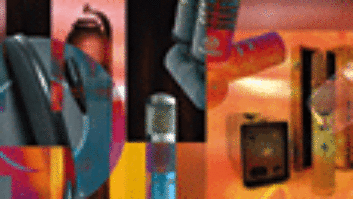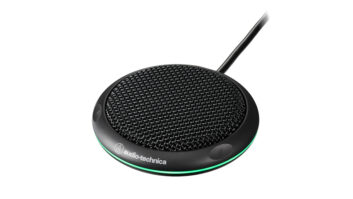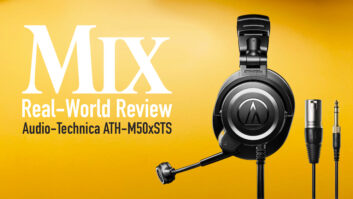STEREO SHOTGUN MICROPHONES
In the rapidly changing world of pro audio, taking things for
granted may not be a good idea. If you think you know what to
expect from a stereo shotgun mic, then you might accidentally
dismiss Audio-Technica’s 9-inch AT835ST ($899) and 15-inch AT815ST
($999). The most obvious thing about these two mics is that, in
addition to being conventional shotgun mics, they offer both M/S
(Mid/Side) and L/R stereo (with both narrow and wide L/R
spreads).
Both mics come in a vinyl box with a mic clip, foam windscreen
and a 5-pin XLR that plugs into the mic and splits into a pair of
3-pin XLRs. The diameter of each mic is slightly larger than a
Sennheiser 416, but small enough to fit properly in a standard
rubber, Rycote boom mount.
Both mics use the same two electret capsules; a front-facing
line-cardioid “mid” capsule and a figure-8
“side” capsule mounted directly behind the mid capsule.
Both mics require 11 to 52 VDC at 4mA phantom power. The longer
AT815ST weighs less than five ounces and the AT835ST less than four
ounces. This makes them well-targeted for the EFP/ENG video markets
with their rapidly growing need for stereo ambient sound or any
other stereo sound gathering application where weight is a
factor.
Using the line-cardioid capsule only in M/S mode, I found the
sensitivity of both A-T mics was 1 or 2 dB below my Sennheiser 416
and 816, and the A-T mics were heard a bit more off of the sides
and to the rear. The level of self-noise was about the same,
although the spectra of the self-noise was different. The
Audio-Technica mics made sort of a “hiiiiiih” compared
to the Sennheisers’ “pfffffff.”
ROLL-OFF REVELATION
One very noticeable difference between these A-T mics and others
I have used is in the design of the LF roll-off filters. The
“flat” frequency response of the shorter AT835ST begins
an LF roll-off at about 500 Hz and gently slopes down -3 dB at 70
Hz and remains there down to 30 Hz. Engaging the LF roll-off switch
actually increases the LF response between 100 and 500 Hz. Below
100 Hz, it drops off more steeply at 12 dB/octave. This means you
get more mid-bass and less low bass with the LF filter engaged.
The AT815ST “flat” response has a 3dB bump in the 30
to 50Hz range that returns to 0 dB at 100 Hz. Engaging the LF
filter causes a 4dB increase between 100 and 400 Hz, which then
drops off gently at about 10 dB/octave below 100 Hz. Again,
engaging the LF filter causes an increase in upper bass and a
decrease in low bass.
Both mics also have presence peaks slightly higher in frequency
than that of the Sennheiser 416. The AT835ST begins a slow 2dB rise
from 1 to about 2.5 kHz. It then achieves a +4dB plateau from 4 to
7 kHz, peaks at +5 dB between 8 and 9 kHz and slopes off moderately
crossing 0 at 15 kHz before dropping down to -4 dB at 20 kHz.
The AT815ST begins a gentle rise at 1 kHz, hits +4 dB at 4 kHz,
dips a decibel or two between 6 and 7 kHz, rises to +5 dB from 8 to
10 kHz, is back down to +3 dB at 15 kHz and slopes off to -1 dB at
20 kHz.
In their flat positions, both mics sound thinner than a 416
Sennheiser. With the LF filters engaged, the increase in upper bass
makes them sound more similar. The 416 still has more beef in the
upper bass and develops its presence peak a bit below that of the
A-T mics, making them sound a bit “zippier” on top. In
my short time with them, I found that I liked keeping them in the
rolled off position to get that extra upper bass, while reducing
the amount of low bass.
I did find that, in stereo operation, as a sound source works
its way from front to rear, there’s a point after the source gets
past the side capsule where the mic gets a bit confused and throws
the signal to the opposite side. As the sound source continues past
the rear axis of the mic and heads back to the front on the other
side, a similar “flip-flop” happens. This occurs in
either L/R mode or in the M/S I matrixed in my Orban Audicy DAW. So
if you’re doing sound work at an automotive road rally, then it’s
probably not a good idea to set up in the middle of a couple of
deep curves that result in the cars crossing the rear axis of the
mic.
Y M/S?
If you haven’t considered M/S stereo, it’s a handy format when
you don’t have a clue as to how wide you want the stereo image in
the final mix. Although it’s a bit difficult to listen to in the
field unless you can convert it to L/R, being able to adjust the
width in post-production is a definite advantage. If you’re using
zone mics, then you can use an M/S mic as a stereo center spot mic
for soloists, using the matrixed mid-channel fader to adjust gain
for the performer without upsetting the stereo balance of the side
channels.
I took the AT835ST to “Open Stage” night at
8×10, a local music hot spot in Baltimore, where Craig Hopwood
runs the house and mixes P.A. Through the 8×10 sound system,
the AT835ST sounded a lot more open and clearer than the Shure Beta
58s. Adding a bit of EQ at the board around 3 to 4 kHz and 10 kHz
made the Betas sound more similar.
Running the mic in L/R wide, I twisted it around 90° so it
was aiming high and low, instead of L/R stereo. Pointing the mic at
about the Adam’s apple of a folk singer, I could get a split of
more voice on one fader and more guitar on the other. In L/R,
harmonized vocals with two singers each about a foot and a half
away from the mic also worked well. When placed a foot away from an
acoustic 12-string guitar, we got a nice image, but ran into
feedback trouble when we added more instruments and had to crank up
the stage monitors. Of course, in the studio or for on-location
recording, feedback just isn’t a problem.
WRAPPING IT UP
The AT835ST and AT815ST are lightweight mics with obvious
EFP/ENG applications, especially with a tailored LF response that
eliminates low end. Having an LF roll-off filter that increases the
middle low frequencies and dumps the lower ones is a great idea
that works out well in the real world. Having slightly
“center-focused” stereo images means you’ll get some
stereo information, but nothing radical that could cause problems
later. With their higher presence peaks and out of the way of
blaring stage monitors, either mic might also find use as a stereo
drum overhead.
Audio-Technica U.S., 1221 Commerce Drive, Stow, OH 44224;
330/686-2600; fax 330/688-3752; www.audio-technica.com.
Reach Ty Ford at www.tyford.com.





